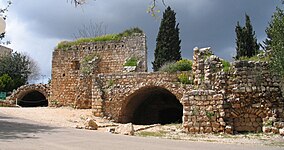Yehi'am Fortress National Park is an Israeli national park in the western Upper Galilee on the grounds of Kibbutz Yehi'am, whose main attraction are the ruins of a hilltop castle of Jiddin. The castle, ruined in the early 14th century, became a small town known as Khirbat Jiddin; the town was depopulated in 1948.
| Yehi'am Fortress National Park | |
|---|---|
 Part of the fortress | |
| Location | Northern District, Israel |
| Nearest city | Yehiam |
| Coordinates | 32°59′39″N 35°13′19″E / 32.9941°N 35.2219°E |
| Official website | |
History edit
On the site are the remains of a small Crusader citadel from the twelfth century, which was destroyed during the Muslim occupation. Flint tools and relics from the Hellenistic period were also found there. The citadel was part of the peripheral fortifications that guarded Acre, which was the capital of the Crusaders after the fall of Jerusalem. From the top of the citadel there is a view of the entire area.
The fort was handed over to the German Teutonic Order in 1208, but about 100 years after its construction it was destroyed by the Mamluk sultan Baybars and nowadays only remnants of the fort remain. The fort was extensively renovated by the Bedouin ruler of the Galilee in the 18th century, Zahir al-Umar, and buildings were added to the upper part. According to a Crusader Christian source, from the thirteenth century the Arabs called the place "Jadin" .
in his tour of the Galilee in the 1860's Victor Guérin mentions Yhi'am Fortress. He describes the place as a large deteriorating castle on the edge of Wadi Jadin, and only a few shepherds live there, whom he calls "men of horror." Gadin Citadel, despite its dilapidated condition, left a strong impression on Guérin, with its sturdy remains on the summit, on which it stands. Under the castle is a complex fortified with towers, with remains of ruined houses, cisterns and bushes. On the north side Guérin saw abandoned orchards.
During the 1936–1939 Arab revolt in Palestine, the fort was a used a hiding place and court house for the Arab gangs. At the foot of the fortress, Kibbutz Yehiam was established in 1946. During Isral's War of Independence, the people of Kibbutz Yehiam fortified themselves in the fort and fought against their Arab attackers.
Today the buildings include a watch tower with a lookout platform and large vaulted hall.[1] Trenches from Israel's 1948 War Of independence lay around the castle and can also be visited too.
Archaeological finds in the park but outside the castle precinct include the remains of a Roman fort, a Byzantine monastery, burial caves, stones inscribed with crosses and fragments of mosaic.[2]
See also edit
References edit
- ^ "www.attractions-in-israel.com/galilee/galilee-national-parks/yehiam-fortress-national-park-%E2%80%93-yehiam-crusader-fortress-protects-settlers-in-1948/". Attractions in Israel. Retrieved 30 July 2013.
- ^ "Help from above – Jerusalem Post". Archived from the original on 11 June 2014. Retrieved 5 February 2016.